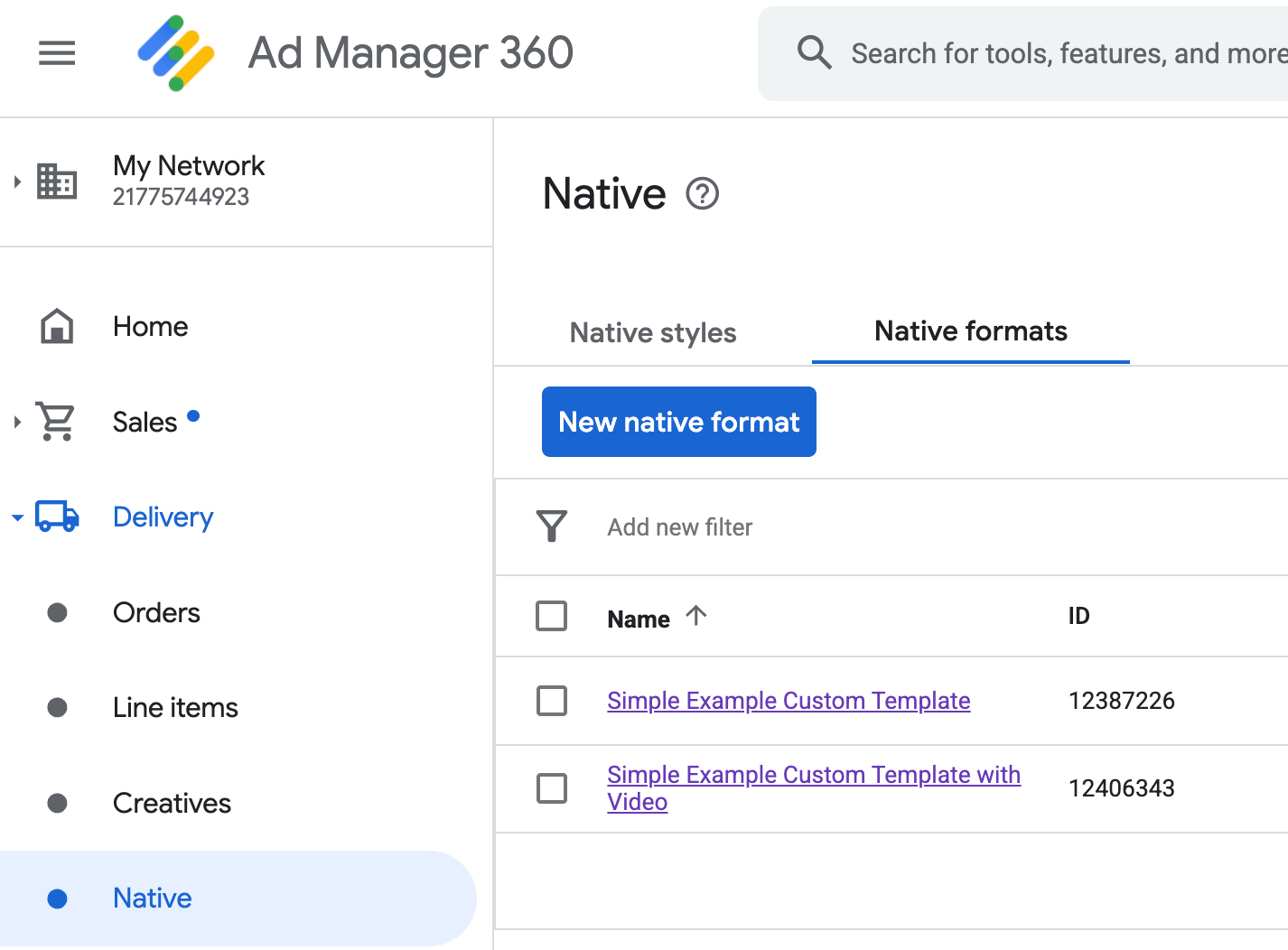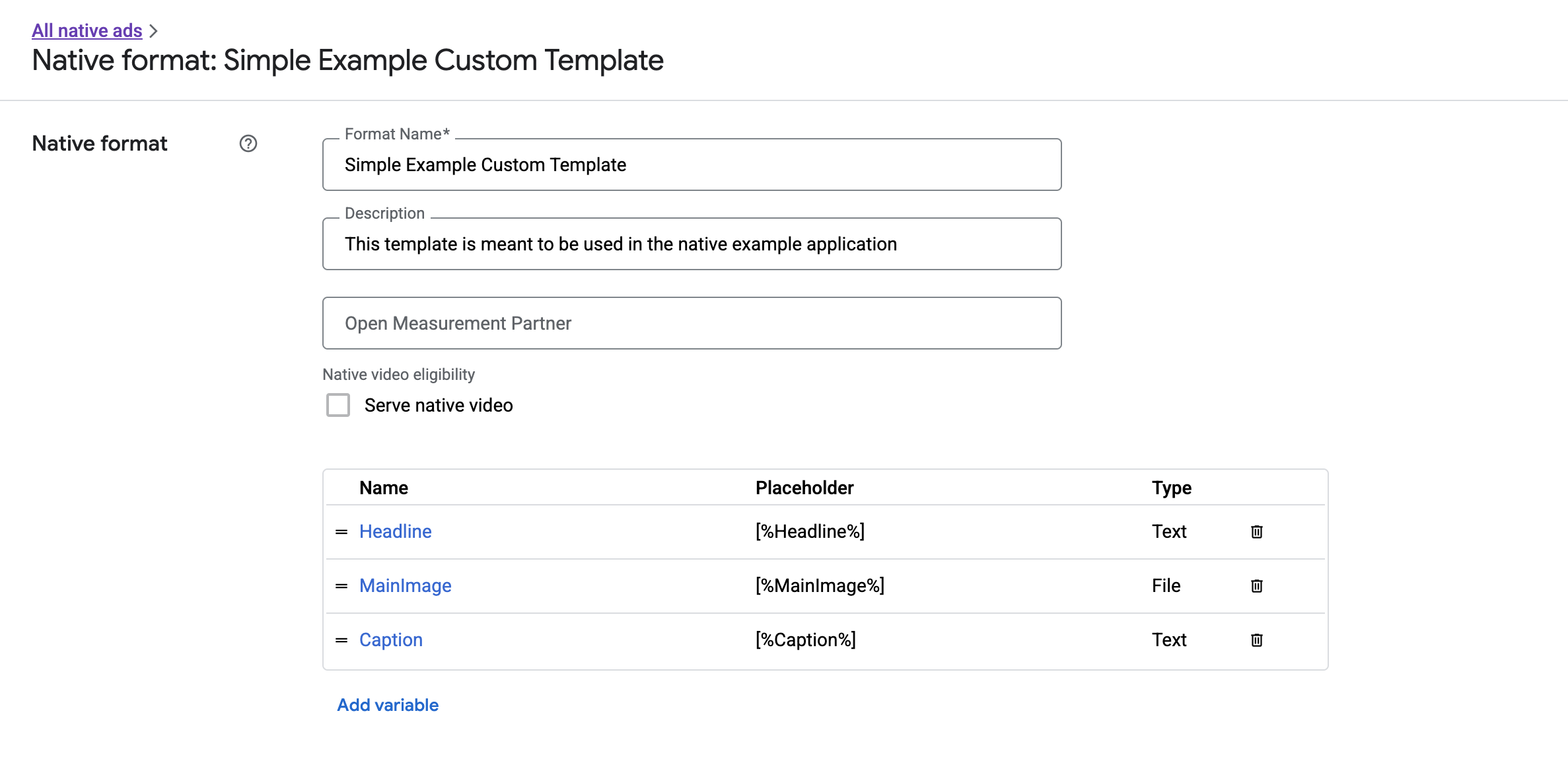除了系統定義的原生格式外,Ad Manager 發布商也能定義自訂素材資源清單,建立自己的原生廣告格式,稱為自訂原生廣告格式,可與預訂廣告一起使用。發布商可透過這種格式,將任意結構化資料傳遞至應用程式。這些廣告會以 NativeCustomFormatAd 物件表示。
載入自訂原生廣告格式
本指南說明如何載入及顯示自訂原生廣告格式。
載入自訂原生廣告
如要載入自訂原生廣告,請按照下列步驟操作:
在
NativeAdType.CUSTOM_NATIVE中加入NativeAdRequest做為廣告類型。設定自訂原生廣告格式 ID。
Kotlin
Java
自訂原生廣告格式 ID
前往 Ad Manager 使用者介面,並在「廣告放送」下拉式選單中選擇「原生」,即可找到用來識別自訂原生廣告格式的專屬 ID:

每個自訂原生廣告格式的 ID 都顯示在名稱旁。點選任一名稱即可進入詳細資料畫面,查看該格式欄位的資訊:

您可以在這裡新增、編輯及移除個別欄位。請記下每個素材資源的「名稱」,在顯示自訂原生廣告格式時,此名稱是用來取得相應資料的關鍵值。
顯示自訂原生廣告格式
自訂原生廣告格式與系統定義格式的不同之處在於,發布商可以自行定義組成廣告的素材資源清單。因此,兩者的顯示流程在某些方面有所差異:
- 文字和圖片素材資源可透過
getText()和getImage()取得,這些 getter 會將欄位名稱做為參數。 - 由於沒有專用的
ViewGroup類別可向 Google 註冊,因此您需要手動記錄曝光和點擊事件。 - 如果廣告不含影片素材資源,自訂原生廣告會顯示
null媒體內容。
這個範例說明如何顯示 CustomNativeAd:
Kotlin
private fun displayCustomNativeAd(customNativeAd: CustomNativeAd, context: Context) {
// Render the text elements.
// The `customNativeAdBinding` is the layout binding for the ad container that
// contains all `CustomNativeAd` assets.
customNativeAdBinding.headline.text = customNativeAd.getText("Headline")
customNativeAdBinding.caption.text = customNativeAd.getText("Caption")
// If the main asset is an image, render it with an ImageView.
val imageView = ImageView(context)
imageView.adjustViewBounds = true
imageView.setImageDrawable(customNativeAd.getImage("MainImage")?.drawable)
imageView.setOnClickListener { customNativeAd.performClick("MainImage") }
customNativeAdBinding.mediaPlaceholder.addView(imageView)
// Render the ad choices icon.
renderAdChoices(customNativeAd)
// Record an impression.
customNativeAd.recordImpression()
}
Java
private void displayCustomNativeAd(CustomNativeAd customNativeAd, Context context) {
// Render the text elements.
// The `customNativeAdBinding` is the layout binding for the ad container that
// contains all `CustomNativeAd` assets.
if (customNativeAdBinding != null) {
customNativeAdBinding.headline.setText(customNativeAd.getText("Headline"));
customNativeAdBinding.caption.setText(customNativeAd.getText("Caption"));
ImageView imageView = new ImageView(context);
imageView.setAdjustViewBounds(true);
imageView.setImageDrawable(customNativeAd.getImage("MainImage").getDrawable());
imageView.setOnClickListener(
new View.OnClickListener() {
@Override
public void onClick(View v) {
customNativeAd.performClick("MainImage");
}
});
customNativeAdBinding.mediaPlaceholder.addView(imageView);
// Render the ad choices icon.
renderAdChoices(customNativeAd);
// Record an impression.
customNativeAd.recordImpression();
}
}
自訂原生廣告格式的原生影片廣告
建立自訂格式時,您可以選擇讓格式支援影片。
在應用程式導入過程中,您可以使用 CustomNativeAd.getMediaContent() 取得媒體內容,然後呼叫 setMediaContent(),在媒體檢視區塊設定媒體內容。如果廣告有 null 媒體內容,請準備不含影片的廣告做為替代方案。
以下範例會檢查廣告是否含有影片內容,並在沒有影片可用時顯示圖片:
Kotlin
private fun displayVideoCustomNativeAd(customNativeAd: CustomNativeAd, context: Context) {
// Check whether the custom native ad has video content.
val mediaContent = customNativeAd.mediaContent
if (mediaContent != null && mediaContent.hasVideoContent) {
// Render the media content in a MediaView.
val mediaView = MediaView(context)
mediaView.mediaContent = mediaContent
customNativeAdBinding.mediaPlaceholder.addView(mediaView)
} else {
// Fall back to other assets defined on your custom native ad.
val imageView = ImageView(context)
imageView.adjustViewBounds = true
imageView.setImageDrawable(customNativeAd.getImage("MainImage")?.drawable)
customNativeAdBinding.mediaPlaceholder.addView(imageView)
}
// Record an impression.
customNativeAd.recordImpression()
}
Java
private void displayVideoCustomNativeAd(CustomNativeAd customNativeAd, Context context) {
// Check whether the custom native ad has video content.
MediaContent mediaContent = customNativeAd.getMediaContent();
if (mediaContent != null && mediaContent.getHasVideoContent()) {
// Render the media content in a MediaView.
MediaView mediaView = new MediaView(context);
mediaView.setMediaContent(mediaContent);
customNativeAdBinding.mediaPlaceholder.addView(mediaView);
} else {
// Fall back to other assets defined on your custom native ad.
ImageView imageView = new ImageView(context);
imageView.setAdjustViewBounds(true);
imageView.setImageDrawable(customNativeAd.getImage("MainImage").getDrawable());
customNativeAdBinding.mediaPlaceholder.addView(imageView);
}
// Record an impression.
customNativeAd.recordImpression();
}
如要進一步瞭解如何控制自訂原生廣告的影片體驗,請參閱「影片廣告」。
顯示 AdChoices 圖示
為遵守《數位服務法》(DSA),在歐洲經濟區 (EEA) 放送的預訂廣告需顯示 AdChoices 圖示,並提供 Google「關於這則廣告」頁面的連結。導入自訂原生廣告時,您需要負責顯示 AdChoices 圖示。在顯示主要廣告素材資源時,我們建議您採取相關步驟,顯示及設定 AdChoices 圖示的點擊事件監聽器。
以下範例假設您已在檢視區塊階層定義 <ImageView /> 元素,以保留 AdChoices 標誌。
<LinearLayout xmlns:android="http://schemas.android.com/apk/res/android">
<ImageView
android:id="@+id/adChoices"
android:layout_width="15dp"
android:layout_height="15dp"
android:adjustViewBounds="true"
android:contentDescription="AdChoices icon." />
</LinearLayout>
以下範例示範如何顯示 AdChoices 圖示,並設定適當點擊行為。
Kotlin
private fun renderAdChoices(customNativeAd: CustomNativeAd) {
// Render the AdChoices image.
val adChoiceAsset = customNativeAd.getImage(NativeAdAssetNames.ASSET_ADCHOICES_CONTAINER_VIEW)
if (adChoiceAsset != null) {
customNativeAdBinding.adchoices.setImageDrawable(adChoiceAsset.drawable)
customNativeAdBinding.adchoices.visibility = View.VISIBLE
customNativeAdBinding.adchoices.setOnClickListener {
// Handle click. See the next section for more details.
customNativeAd.performClick(NativeAdAssetNames.ASSET_ADCHOICES_CONTAINER_VIEW)
}
} else {
customNativeAdBinding.adchoices.visibility = View.GONE
}
}
Java
private void renderAdChoices(CustomNativeAd customNativeAd) {
// Render the AdChoices image.
Image adChoiceAsset =
customNativeAd.getImage(NativeAdAssetNames.ASSET_ADCHOICES_CONTAINER_VIEW);
if (adChoiceAsset != null) {
if (customNativeAdBinding != null) {
customNativeAdBinding.adchoices.setImageDrawable(adChoiceAsset.getDrawable());
customNativeAdBinding.adchoices.setVisibility(View.VISIBLE);
customNativeAdBinding.adchoices.setOnClickListener(
new View.OnClickListener() {
@Override
public void onClick(View v) {
// Handle click.
customNativeAd.performClick(NativeAdAssetNames.ASSET_ADCHOICES_CONTAINER_VIEW);
}
});
}
} else {
if (customNativeAdBinding != null) {
customNativeAdBinding.adchoices.setVisibility(View.GONE);
}
}
}
記錄曝光次數及回報點擊事件
您的應用程式必須負責記錄曝光次數,並向 Google Mobile Ads SDK (Beta 版) 回報點擊事件。
記錄曝光次數
如要記錄自訂原生廣告的曝光次數,請呼叫廣告的 recordImpression() 方法:
Kotlin
// Record an impression.
customNativeAd.recordImpression()
Java
// Record an impression.
customNativeAd.recordImpression();
如果應用程式意外對相同廣告呼叫該方法兩次,SDK 會自動避免在單次請求中重複記錄曝光次數。
回報點擊
如要向 SDK 回報某個素材資源檢視區塊的點擊事件,請呼叫廣告的 performClick() 方法。使用您在 Ad Manager 使用者介面中定義的相同字串,提供已點選的素材資源名稱。
Kotlin
imageView.setOnClickListener { customNativeAd.performClick("MainImage") }
Java
imageView.setOnClickListener(
new View.OnClickListener() {
@Override
public void onClick(View v) {
customNativeAd.performClick("MainImage");
}
});
請注意,您不需要對廣告中的每個檢視區塊呼叫這個方法。舉例來說,如果名為「Caption」的欄位只用來顯示內容,無法點按或輕觸,應用程式就不必對這個素材資源的檢視區塊呼叫 performClick。
回應自訂點擊動作
當使用者點選自訂格式廣告,SDK 會依序嘗試以下三種可能回應:
- 叫用
OnCustomClickListener(如有)。 - 針對廣告的每個深層連結網址,嘗試找出內容解析器,並啟動實際執行解析的第一個解析器。
- 開啟瀏覽器,前往廣告的到達網頁網址。
如要導入自訂點擊動作,請提供 OnCustomClickListener:
Kotlin
customNativeAd.onCustomClickListener =
object : OnCustomClickListener {
override fun onCustomClick(assetName: String) {
// Perform your custom action.
}
}
Java
customNativeAd.setOnCustomClickListener(
new OnCustomClickListener() {
@Override
public void onCustomClick(@NonNull String assetName) {
// Perform your custom action.
}
});
一開始,您可能會覺得自訂點擊事件監聽器很奇怪。畢竟應用程式才剛告訴 SDK 發生了點擊事件,為什麼 SDK 還要再回報給應用程式呢?
其實這種資訊流動有不少好處,最重要的一點是 SDK 能掌控點擊事件的處理方式。比方說,您無需額外撰寫程式碼,SDK 就會自動連線偵測 (ping) 廣告素材設定的第三方追蹤網址,並在背景處理其他工作。

